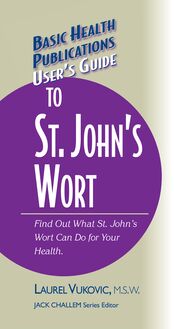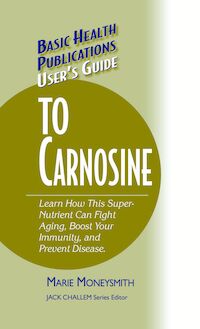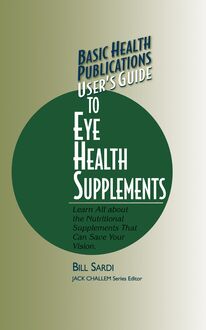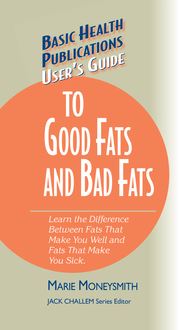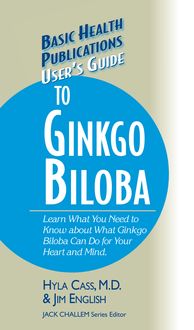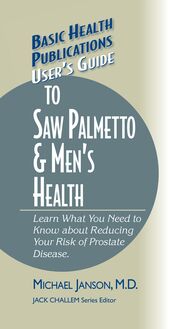User's Guide to Echinacea and Other Cold & Flu Fighters , livre ebook
43
pages
English
Ebooks
2004
Vous pourrez modifier la taille du texte de cet ouvrage
Obtenez un accès à la bibliothèque pour le consulter en ligne En savoir plus
Découvre YouScribe en t'inscrivant gratuitement
Découvre YouScribe en t'inscrivant gratuitement
43
pages
English
Ebooks
2004
Vous pourrez modifier la taille du texte de cet ouvrage
Obtenez un accès à la bibliothèque pour le consulter en ligne En savoir plus
Publié par
Date de parution
01 janvier 2004
Nombre de lectures
0
EAN13
9781591206613
Langue
English
Poids de l'ouvrage
1 Mo
Publié par
Date de parution
01 janvier 2004
Nombre de lectures
0
EAN13
9781591206613
Langue
English
Poids de l'ouvrage
1 Mo
The information contained in this book is based upon the research and personal and professional experiences of the author. It is not intended as a substitute for consulting with your physician or other healthcare provider. Any attempt to diagnose and treat an illness should be done under the direction of a healthcare professional.
The publisher does not advocate the use of any particular healthcare protocol but believes the information in this book should be available to the public. The publisher and author are not responsible for any adverse effects or consequences resulting from the use of the suggestions, preparations, or procedures discussed in this book. Should the reader have any questions concerning the appropriateness of any procedures or preparations mentioned, the author and the publisher strongly suggest consulting a professional healthcare advisor.
Series Editor: Jack Challem Editor: Gina Friedlander Typesetter: Gary A. Rosenberg Series Cover Designer: Mike Stromberg
Basic Health Publications User’s Guides are published by Basic Health Publications, Inc.
8200 Boulevard East North Bergen, NJ 07047 1-800-575-8890
Copyright © 2004 by Laurel Vukovic, M.S.W.
ISBN 13: 978-1-59120-661-3
ISBN: 1-59120-084-9
All rights reserved. No part of this publication may be reproduced, stored in a retrieval system, or transmitted, in any form or by any means, electronic, mechanical, photocopying, recording, or otherwise, without the prior written consent of the copyright owner.
Printed in the United States of America
10 9 8 7 6 5 4 3 2 1
C ONTENTS
Introduction
1. How Colds and Flus “Catch You”
2. Simple Ways to Strengthen Your Immune System
3. Immune-Boosting Herbs: Echinacea and Astragalus
4. Virus-Fighting Herbs: Elderberry and Garlic
5. Virus-Fighting Nutrients: Vitamin C, N-acetylcysteine, and Zinc
6. Why You Shouldn’t Take Drugs for Colds and Flus
7. Home Remedies for Colds and Flus
8. How to Buy and Use Supplements and Herbs
Conclusion
Selected References
Other Books and Resources
I NTRODUCTION
C hances are, you’re going to come down with a cold or flu this year. If you’re like most people, you have an assortment of pain relievers, decongestants, cough syrups, and other over-the-counter and prescription drugs that you’ve collected for easing the misery of a cold or flu.
But did you know that although such medicines may give you temporary relief from cold and flu symptoms, studies have shown that taking such drugs actually prolongs the length of time that you will be sick? Instead of getting well faster, you could be sick for twice as long as if you took nothing at all. In addition, many of the medications for colds and flus have unpleasant and even hazardous side effects, ranging from drowsiness to heart rhythm disturbances.
There is another serious drawback to using drugs. The antibiotic prescriptions that are frequently handed out for treating colds and flus are now recognized as a primary factor in the evolution of killer germs—bacteria that are drug-resistant and highly dangerous.
Fortunately, there are safe and effective alternatives to pharmaceutical drugs. Herbs such as echinacea, elderberry, astragalus, and garlic are key players in helping to strengthen the body’s natural defenses against the viruses that cause colds and flus. And nutrients such as vitamin C, N-acetylcysteine, and zinc provide essential support to your body’s immune system. Using herbs and nutritional supplements is radically different from using medications that simply mask the symptoms of a cold or flu. When you use natural remedies, you are enhancing your immune function, building your resistance to invading microorganisms, and improving your overall health.
In this book, you’ll learn how cold and flu viruses operate, and how you can avoid them. You’ll also discover how you can enhance your body’s innate ability to fend off viruses. And if you do occasionally come down with a cold or flu, you’ll learn how to relieve the uncomfortable symptoms naturally, safely, and effectively and speed your recovery.
CHAPTER 1
H OW C OLDS AND F LUS “C ATCH Y OU ”
C olds and flus are the most common illnesses that plague humankind. Statistically, you’re likely to come down with a cold up to four times this year (young children can catch up to a dozen colds per year), and according to the United States Centers for Disease Control and Prevention (CDC), between 35 and 50 million Americans are striken with the flu each year. Antibiotics are useless against these illnesses because they are caused by viruses, not by bacteria. Over-the-counter medications offer little more than temporary relief from symptoms and may actually do more harm than good.
But there are many things that you can do to prevent colds and flus. Understanding how the viruses operate is a good starting point for gaining the knowledge that will give you the upper hand over these annoying and debilitating illnesses.
The Difference Between Colds and Flus
Colds and flus have a lot in common, but there are also some significant differences. Figuring out which is which can help you to identify the remedies that best suit your needs.
Colds are upper respiratory illnesses that can be caused by more than 200 different viruses. Although each virus actually causes a different cold, because the symptoms are so similar we think of them as a single illness—the common cold. The symptoms of a cold typically begin with minor throat irritation and progress, often within a matter of hours, to a full-blown sore throat, runny nose, nasal congestion, sneezing, and coughing. The nasal discharge that accompanies a cold is usually clear and runny for the first couple of days and then becomes thick and turns greenish yellow. The residual cough and congestion of a cold can last for one to two weeks and sometimes even longer. A fever accompanies only about 10 percent of colds and tends to be very mild in adults. In children, fever associated with a cold may run as high as 103°F for a couple of days.
Although colds rarely cause serious complications, they can lay the groundwork for subsequent problems such as sinus or middle-ear infections. Colds can also exacerbate asthma and can sometimes be followed by lingering bronchial irritation or infections. Young children are especially susceptible to painful middle-ear infections, which are linked to the cold virus. Sinusitis more commonly affects adults and is an infection of the sinus cavities with symptoms of nasal congestion, pressure or pain in the sinuses, headache, and a yellowish-green mucous discharge.
More serious respiratory infections such as bronchitis and pneumonia can also follow a cold, especially for the elderly or those with lowered immunity. Bronchitis is an infection of the bronchi, the tubes that carry air to the lungs. Symptoms include a persistent phlegm-producing cough and breathlessness. Acute bronchitis is usually caused by a virus and can last from a few days to two weeks or longer.
Bronchitis An infection of the tubes that carry air to the lungs.
Pneumonia is a potentially dangerous viral or bacterial infection of one or both lungs. The symptoms include fever, chills, breathlessness, chest pain, and a cough that produces yellow or green phlegm, sometimes tinged with blood.
Pneumonia A bacterial or viral infection of the lungs.
In contrast to a cold, the flu (medically termed influenza) is a respiratory illness that is caused by a specific virus and is always more severe than a cold. The symptoms of flu include a high fever (up to 104°F), sore throat, coughing, head ache, fatigue, nasal congestion, and aching joints and muscles. The in tense symptoms of the flu generally last for about a week with residual fatigue lingering for an additional week or two.
Influenza (flu) Respiratory illness caused by a virus.
The most serious complication of the flu is pneumonia, which can develop about five days following a bout with influenza in susceptible people. Although pneumonia is unlikely in healthy adults, the risk is very high for certain groups of people, including the elderly, very young children, and those with weakened immune systems. In addition, people with heart or lung diseases are at a higher risk of dying from the flu.
Why the Flu Can Be Deadly
Although for most of us influenza means just an uncomfortable few days in bed, there’s no doubt that it can be deadly. As recently as 1918, a flu epidemic killed more than 25 million people around the world. The CDC estimates that in a typical year more than 100,000 people in the United States are hospitalized as a result of the flu, and close to 20,000 people die from the virus and its complications, such as pneumonia. However, if the strain of influenza is especially virulent, the number of hospitalizations and deaths sky rockets. Influenza epidemics are most dangerous when they involve a flu virus to which most people have not been previously exposed—such as a new strain of the flu or one that has not been circulating for many decades. In such cases, the virus can quickly spread throughout the world and is referred to as a pandemic.
Pandemic A worldwide epidemic.
Knowing a little about how flu viruses operate can help you understand how to best protect yourself against these troublemaking microorganisms. In simple scientific terms, flu viruses are chains of genetic material encased in protein membranes, surrounded by a fatty envelope embedded with glycoprotein spikes. There are three recognized strains of influenza, determined by whether they have one or two protein membranes and the makeup of the glycoprotein spikes.
The three types of influenza viruses are identified as A, B, and C. The most common types are A and B. The type A virus is the one that is the most prevalent, is constantly mutating, and is the type that has caused the most devastating worldwide epidemics. The type A virus also is generally concentrated i

